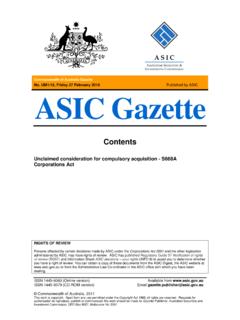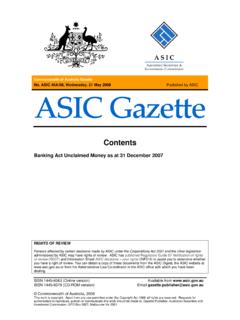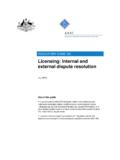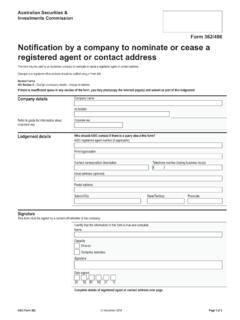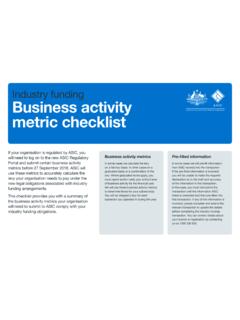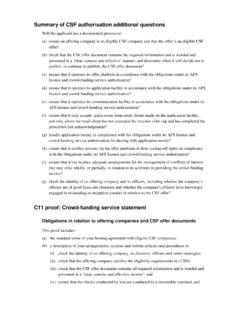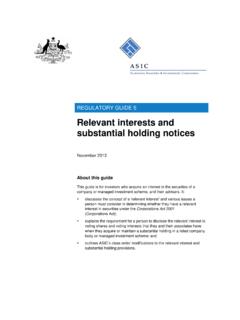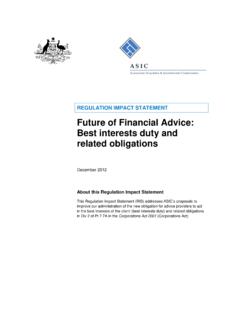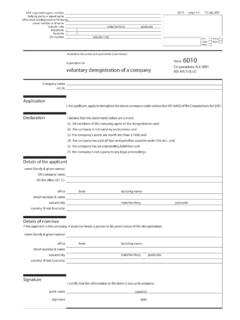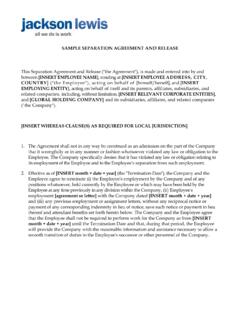Transcription of Related party transactions - ASIC
1 REGULATORY GUIDE 76 Related party transactions March 2011 About this guide This guide sets out our guidance to promote better disclosure and governance for Related party transactions . It is designed for public companies, responsible entities of registered managed investment schemes, experts, public company directors and their professional advisers. REGULATORY GUIDE 76: Related party transactions Australian Securities and Investments Commission March 2011 Page 2 About ASIC regulatory documents In administering legislation ASIC issues the following types of regulatory documents.
2 Consultation papers: seek feedback from stakeholders on matters ASIC is considering, such as proposed relief or proposed regulatory guidance. Regulatory guides: give guidance to regulated entities by: explaining when and how ASIC will exercise specific powers under legislation (primarily the Corporations Act) explaining how ASIC interprets the law describing the principles underlying ASIC s approach giving practical guidance ( describing the steps of a process such as applying for a licence or giving practical examples of how regulated entities may decide to meet their obligations).
3 Information sheets: provide concise guidance on a specific process or compliance issue or an overview of detailed guidance. Reports: describe ASIC compliance or relief activity or the results of a research project. Document history This version was issued on 30 March 2011 and is based on legislation and regulations as at 30 March 2011. Previous versions: Superseded Policy Statement 76, issued 23 December 1993, updated 31 January 1994, 23 January 1995 and 3 March 1997, and rebadged as a regulatory guide 5 July 2007 Disclaimer This guide does not constitute legal advice.
4 We encourage you to seek your own professional advice to find out how the Corporations Act and other applicable laws apply to you, as it is your responsibility to determine your obligations. Examples in this guide are purely for illustration; they are not exhaustive and are not intended to impose or imply particular rules or requirements. REGULATORY GUIDE 76: Related party transactions Australian Securities and Investments Commission March 2011 Page 3 Contents A Overview .. 4 What this guide is about .. 4 Purpose of this guide .. 5 Overview of legal framework for Related party transactions .
5 6 Application of this guide .. 7 B Directors meetings voting restrictions .. 8 Restrictions on voting section 195 .. 8 Quorum of directors .. 9 Material personal interest ..10 ASIC s relief powers ..11 Content of applications and relief ..12 Other obligations ..14 C The arm s length exception ..15 The s210 exception and the meaning of arm s length ..15 Relevant factors to consider when applying the s210 exception ..17 Seeking member approval when there is uncertainty ..21 D Member approval process ..22 Content of explanatory statements.
6 22 Expert reports ..27 ASIC s review of meeting materials ..29 Voting exclusions for resolutions at members meetings ..31 ASIC s relief powers ..31 E Disclosure documents ..33 Disclosure to investors about Related party transactions ..33 Key terms ..37 Related information ..39 REGULATORY GUIDE 76: Related party transactions Australian Securities and Investments Commission March 2011 Page 4 A Overview Key points There is a risk that the interests of a Related party may influence the decision-making of directors to the detriment of the interests of members of the entity as a whole when an entity is considering whether to enter into a transaction with a Related party .
7 Together with the provisions about directors duties , the Corporations Act 2001 (Corporations Act) imposes a number of protections to help manage this risk, including: Div 2 of Pt , which excludes directors of public companies with material personal interests in certain matters attending director meetings about, or voting on, these matters; and Ch 2E and Pt , which require public companies and responsible entities of registered managed investment schemes to obtain member approval to provide a financial benefit to a Related party , subject to certain exceptions.
8 This guide provides guidance for public companies and registered managed investment schemes (registered schemes) on the application of the Corporations Act and ASIC s expectations in relation to various aspects of Related party transactions . These include the decision to enter into a Related party transaction, whether to seek member approval, and what information to include in meeting materials for the approval of Related party transactions and other disclosure documents. What this guide is about RG A Related party transaction is any transaction through which a public company or registered managed investment scheme provides a financial benefit to a Related party (such as a director, their spouse and certain other relatives).
9 Almost by definition, Related party transactions involve conflicts of interest because Related parties are often in a position to influence the decision of whether the benefit is provided to them, and the terms of its provision. RG This regulatory guide covers the matters set out in Table 1. REGULATORY GUIDE 76: Related party transactions Australian Securities and Investments Commission March 2011 Page 5 Table 1: Summary of our guidance on Related party transactions What decision is being made What our guidance covers Where to find it Whether to enter into a Related party transaction Voting restrictions for directors at directors meetings and when we may give relief from these restrictions Note.
10 This guidance applies when a director has an interest in the matter being considered at the meeting, regardless of whether the matter is a Related party transaction. Section B Whether to seek member approval The arm s length exception in s210, including factors to consider when applying this exception Section C What to include in notices of meeting and explanatory statements (meeting materials) if member approval is sought The requirements of s218 and 219, the focus of our review of meeting materials and the exercise of our powers to shorten the 14-day review period or issue comments on the meeting materials Section D Which votes to count at a members meeting Voting exclusions for Related parties at members meetings and when we may give relief from the relevant provisions Section D What to include about Related party transactions in other disclosures The content of other disclosures to investors (including prospectuses.)
